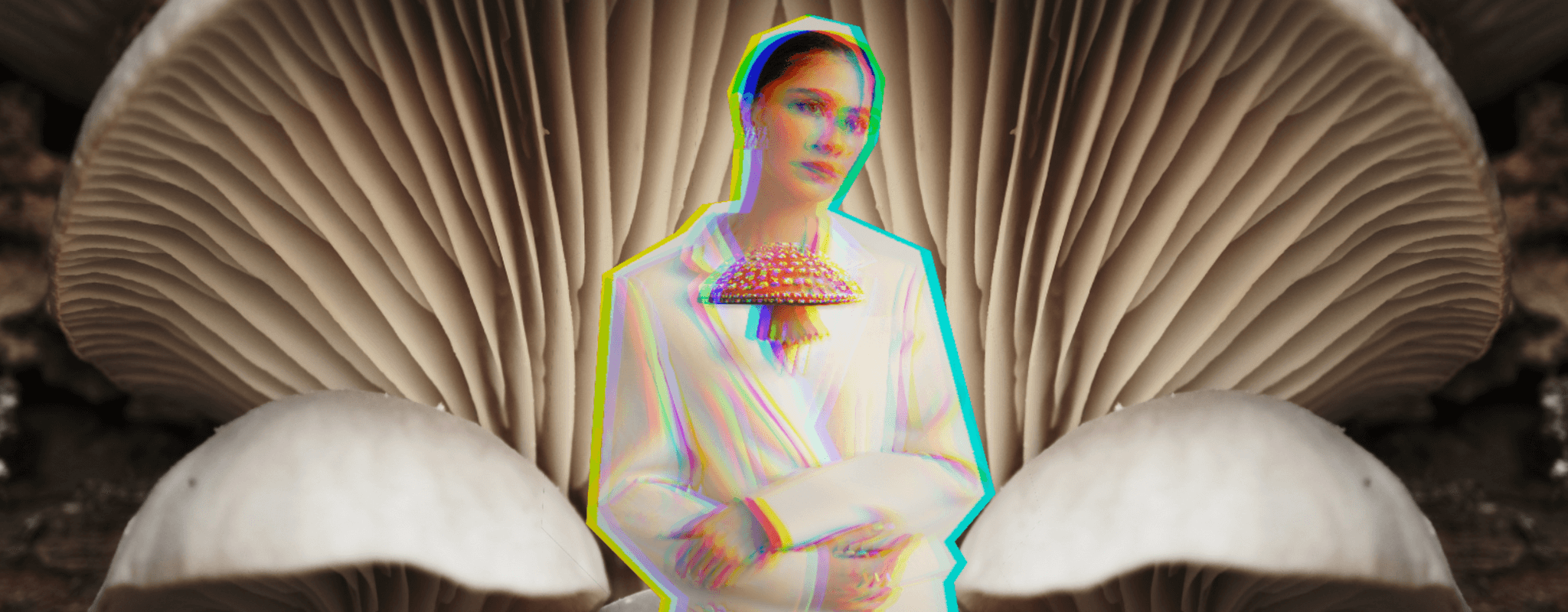Mushrooms are setting a trend in fashion this year, and not only as prints and 3D flounces, but especially as an innovative and promising material! Yet it’s not the actual mushrooms that we should be talking about, but mycelium. What is mycelium, and how can mushroom fashion and mycelium revolutionise the fashion industry, you ask? We at SANVT will tell you all about it!
If we look at the prints of many high fashion collections this year, with their trippy inspirations and psychedelic flounders, we might think shrooms have already infiltrated high fashion. But what the fashion industry is even more hyped on is the miracle material that is mycelium. That's because mycelium can be used to make plant-based leather alternatives and vegan, durable, and biodegradable materials with very little resources. Mushroom fashion and mushroom leather is therefore getting more and more attention as one of the most promising and revolutionary materials in the fashion industry. But what exactly is mycelium, and how is it different from mushrooms?

What is mycelium?
Why are we talking about mushroom fashion and mushroom leather when we are actually talking about mycelium? Quite simply because mycelium, the main part of the organism, isn’t quite as well known as its visible part, the mushroom. Mycelium is the root-like structure of the fungus, which consists of a mass of branched, filamentous hyphae. Mycelium creates huge underground networks through which the fungi transmit electrical impulses and signals for the transmission of information. Accordingly, mycelium – as a so-called "wood wide web" – serves as a means of communication.
A study by the University of the West of England in Bristol supports this theory. In the study, mycelium was connected to electrodes to measure electrical signals, and electrical amplitudes ranging from 0.03 millivolts to 2.1 millivolts were detected. The voltage spikes also occur in a similar form in neurons. Mycelium can thus be described as the nervous system of the earth, through which all trees, forests, plants, and fungi communicate with each other. Pretty trippy, isn't it?

Mushroom fashion and mushroom leather
How exactly does mycelium find use in fashion, though? When we talk about mushroom fashion, we are mainly talking about mushroom leather, which is plant-based, sustainable, biodegradable, and resource-efficient. Here, the innovative, environmentally- and animal- friendly "leather" is pressed and then tanned like real leather (without the use of chemicals at all). The dense root fibers of the mycelium are first mixed with various waste products such as corn husks, causing the mycelia to multiply and form mold after a few days. The mass is then mashed, pressed, dried, and tanned.
The result not only looks like leather, but also feels like it and has an even more flexible elasticity. Mushroom leather is chemical-free, antibacterial, antiseptic, and has a marbled, velvety, and heat-insulating surface. Also, unlike many other vegan leather alternatives, mushroom leather is water repellent, tear resistant, and breathable, guaranteeing a much more durable product than one made from pineapple leather, for example. Not to mention that, unlike animal leather, it does not cause any suffering and is therefore cruelty free. The production of mushroom leather is also extremely resource-friendly, climate-friendly, and does not create any waste.
We can now buy products made from mushroom leather at Adidas, Stella McCartney, Lululemon, Alexander McQueen, and even Hermès. Thus, mushroom leather has gained an entry into the luxury sector, which testifies to the high quality of the climate-friendly material.

Mushroom fashion: conclusion
Mushrooms are definitely one of the least appreciated wonders of our planet! The species is estimated to include more than 3.8 million kinds of fungi worldwide. This makes fungi the second largest kingdom of organisms after animals, and exceeds the diversity of plants by about 10 times! Among the millions of mushrooms, there are a lot of species with medicinal properties: some of them are used in therapy thanks to the psychoactive substance psilocybin, while others, such as the tinder fungus or reishi, are used in cosmetics and Ayurvedic cures.
While mushrooms have shown potential in the fight against Alzheimer, cancer, and neurodermatitis, it is now bound to revolutionise the fashion world with its ability to create environmentally-friendly materials. What’s even more promising is that mycelium can be processed not only into mushroom leather, but also into robust building materials, plastic alternatives, and packaging. The fact that mycelium is the nervous system of the earth and forms a network between all living things also gives us a whole new understanding of our natural ecosystems. As we at SANVT are passionate about making fashion more sustainable, it is needless to say that we’re in awe of mushrooms. This clearly makes mushroom fashion our new obsession!
And if you want to learn more about fungi and mycelium, then the documentary Fantastic Fungi on Netflix is an absolute must-watch.

